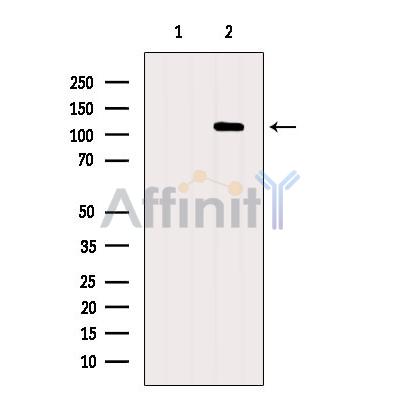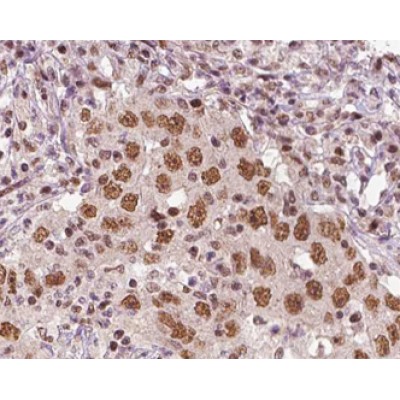XRN2 Antibody - #AF0490
| Product: | XRN2 Antibody |
| Catalog: | AF0490 |
| Description: | Rabbit polyclonal antibody to XRN2 |
| Application: | WB IHC IF/ICC |
| Reactivity: | Human, Mouse, Monkey |
| Prediction: | Pig, Zebrafish, Bovine, Horse, Sheep, Rabbit, Dog, Chicken, Xenopus |
| Mol.Wt.: | 108kDa; 109kD(Calculated). |
| Uniprot: | Q9H0D6 |
| RRID: | AB_2834320 |
Related Downloads
Protocols
Product Info
*The optimal dilutions should be determined by the end user. For optimal experimental results, antibody reuse is not recommended.
*Tips:
WB: For western blot detection of denatured protein samples. IHC: For immunohistochemical detection of paraffin sections (IHC-p) or frozen sections (IHC-f) of tissue samples. IF/ICC: For immunofluorescence detection of cell samples. ELISA(peptide): For ELISA detection of antigenic peptide.
Cite Format: Affinity Biosciences Cat# AF0490, RRID:AB_2834320.
Fold/Unfold
5' 3' exoribonuclease 2; DHM1 like protein; DHP protein; XRN 2;
Immunogens
A synthesized peptide derived from human XRN2, corresponding to a region within N-terminal amino acids.
Expressed in the spleen, thymus, prostate, testis, ovary, small intestine, colon, peripheral blood leukocytes, heart, brain, placenta, lung, liver, skeletal muscle, kidney, and pancreas. Isoform 2 is expressed predominantly in peripheral blood leukocytes.
- Q9H0D6 XRN2_HUMAN:
- Protein BLAST With
- NCBI/
- ExPASy/
- Uniprot
MGVPAFFRWLSRKYPSIIVNCVEEKPKECNGVKIPVDASKPNPNDVEFDNLYLDMNGIIHPCTHPEDKPAPKNEDEMMVAIFEYIDRLFSIVRPRRLLYMAIDGVAPRAKMNQQRSRRFRASKEGMEAAVEKQRVREEILAKGGFLPPEEIKERFDSNCITPGTEFMDNLAKCLRYYIADRLNNDPGWKNLTVILSDASAPGEGEHKIMDYIRRQRAQPNHDPNTHHCLCGADADLIMLGLATHEPNFTIIREEFKPNKPKPCGLCNQFGHEVKDCEGLPREKKGKHDELADSLPCAEGEFIFLRLNVLREYLERELTMASLPFTFDVERSIDDWVFMCFFVGNDFLPHLPSLEIRENAIDRLVNIYKNVVHKTGGYLTESGYVNLQRVQMIMLAVGEVEDSIFKKRKDDEDSFRRRQKEKRKRMKRDQPAFTPSGILTPHALGSRNSPGSQVASNPRQAAYEMRMQNNSSPSISPNTSFTSDGSPSPLGGIKRKAEDSDSEPEPEDNVRLWEAGWKQRYYKNKFDVDAADEKFRRKVVQSYVEGLCWVLRYYYQGCASWKWYYPFHYAPFASDFEGIADMPSDFEKGTKPFKPLEQLMGVFPAASGNFLPPSWRKLMSDPDSSIIDFYPEDFAIDLNGKKYAWQGVALLPFVDERRLRAALEEVYPDLTPEETRRNSLGGDVLFVGKHHPLHDFILELYQTGSTEPVEVPPELCHGIQGKFSLDEEAILPDQIVCSPVPMLRDLTQNTVVSINFKDPQFAEDYIFKAVMLPGARKPAAVLKPSDWEKSSNGRQWKPQLGFNRDRRPVHLDQAAFRTLGHVMPRGSGTGIYSNAAPPPVTYQGNLYRPLLRGQAQIPKLMSNMRPQDSWRGPPPLFQQQRFDRGVGAEPLLPWNRMLQTQNAAFQPNQYQMLAGPGGYPPRRDDRGGRQGYPREGRKYPLPPPSGRYNWN
Predictions
Score>80(red) has high confidence and is suggested to be used for WB detection. *The prediction model is mainly based on the alignment of immunogen sequences, the results are for reference only, not as the basis of quality assurance.
High(score>80) Medium(80>score>50) Low(score<50) No confidence
Research Backgrounds
Possesses 5'->3' exoribonuclease activity (By similarity). May promote the termination of transcription by RNA polymerase II. During transcription termination, cleavage at the polyadenylation site liberates a 5' fragment which is subsequently processed to form the mature mRNA and a 3' fragment which remains attached to the elongating polymerase. The processive degradation of this 3' fragment by this protein may promote termination of transcription. Binds to RNA polymerase II (RNAp II) transcription termination R-loops formed by G-rich pause sites.
Nucleus>Nucleolus.
Expressed in the spleen, thymus, prostate, testis, ovary, small intestine, colon, peripheral blood leukocytes, heart, brain, placenta, lung, liver, skeletal muscle, kidney, and pancreas. Isoform 2 is expressed predominantly in peripheral blood leukocytes.
Belongs to the 5'-3' exonuclease family. XRN2/RAT1 subfamily.
Research Fields
· Genetic Information Processing > Translation > Ribosome biogenesis in eukaryotes.
· Genetic Information Processing > Folding, sorting and degradation > RNA degradation.
Restrictive clause
Affinity Biosciences tests all products strictly. Citations are provided as a resource for additional applications that have not been validated by Affinity Biosciences. Please choose the appropriate format for each application and consult Materials and Methods sections for additional details about the use of any product in these publications.
For Research Use Only.
Not for use in diagnostic or therapeutic procedures. Not for resale. Not for distribution without written consent. Affinity Biosciences will not be held responsible for patent infringement or other violations that may occur with the use of our products. Affinity Biosciences, Affinity Biosciences Logo and all other trademarks are the property of Affinity Biosciences LTD.



